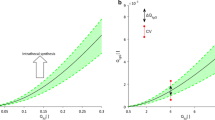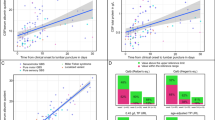Summary
A graph for the evaluation of the CSF-protein profile is presented as a basic program for the clinical-neurochemical laboratory.
The graph has the following advantages:
Simultaneous information on the functional state of the blood-CSF barrier and the inflammatory response of the CNS;
maximal sensitivity for the determination of a pathological local IgG production in CNS—with the possibility of calculating the IgG fraction in CSF originating from the CNS;
minimal number of protein assays necessary (albumin and IgG in serum and CSF);
suitable for the demonstration of the course of the disease in a single patient as well as for demonstration of a group of cases for statistical purposes.
Complementary chemical investigations and the correspondence with the clinical diagnosis are discussed for a number of typical cases.
Two different types of blood-CSF barrier dysfunctions are discriminated by a proportional and an dis-proportionate increase of the CSF/serum protein concentration gradients.
Zusammenfassung
Ein Schema zur optimalen Auswertung des Liquorprotein-Profils als Grundprogramm des klinisch-neurochemischen Laborbefundes wird berichtet.
Dieses Schema hat folgende Vorteile:
Simultane Information über den Zustand der Blut-Liquor-Schranke und den entzündlichen Prozeß des Zentralnervensystems, d.h. unmittelbar einsichtige Unterscheidung zwischen verschiedenen Liquordysproteinosen;
maximale Empfindlichkeit für pathologische Abweichungen vom Normalbereich im Falle einer autochthonen IgG-Produktion im ZNS mit der Möglichkeit der Berechnung des im ZNS synthetisierten Anteils an der IgG-Fraktion des Liquors;
nur eine minimale Zahl von Analysen notwendig (Albumin und IgG im Liquor und Serum);
geeignet für die Darstellung des Krankheitsverlaufs eines einzelnen Patienten und für die Darstellung von Kollektiven für statistische Zwecke.
Ergänzende Laboruntersuchungen und der Zusammenhang mit der klinischen Diagnose werden an Fallbeispielen dargestellt.
Zwei verschiedene Arten der Schrankenstörung werden berichtet. Im einen Fall ist die Zunahme der Liquor/Serum-Konzentrationsgradienten verschiedener Proteine untereinander proportional, im anderen Fall unproportional.
Similar content being viewed by others
References
Bauer H (1967) Physiologie und Pathologie des Liquors. In: Cobet R, Gutzeit R, Bock HE, Hartmann F (eds) Klinik der Gegenwart, Vol IV, E 367–388. Urban und Schwarzenberg, München
Delank H-W (1978) Das normale Liquoreiweißbild und seine pathologischen Veränderungen. Lab med 2:95–98
Delmotte P, Gonsette R (1977) Biochemical findings in MS. IV. Isoelectric focusing of the CSF gamma globulins in MS and other neurological diseases. J Neurol 215:27–37
Delpech B, Lichtblau E (1972) Immunochemical estimation of IgG and albumin in cerebrospinal fluid. Clin Chim Acta 37:15–23
Dommasch D, Mertens HG (eds) (1980) Cerebrospinalflüssigkeit-CSF. Thieme, Stuttgart New York
Eickhoff K, Heipertz R (1977) Discrimination of elevated IgG concentrations in CSF due to inflammatory reaction of the central nervous system and blood-brain-barrier dysfunction. Acta Neurol Scandinav 56:475–482
Engelhardt P, Stamm T (1979) Cell collection from CSF. Comparison of different methods. J Clin Chem Clin Biochem 17:510
Felgenhauer K (1974) Protein size and cerebrospinal fluid composition. Klin Wochenschr 52:1158–1164
Ganrot K, Laurell CB (1974) Measurement of IgG and albumin content of cerebrospinal fluid and its interpretation. Clin Chem 20:571–573
Kleine TO, Baerlocher K, Niederer V, Keller H, Reutter F, Tritschler W, Bablock W (1979) Diagnostische Bedeutung der Lactatbestimmung im Liquor bei Meningitis. Dtsch med Wochenschr 104:553–557
Kölmel HW (1979) Meningitis und Liquorzytologie. Nervenarzt 50:5–9
Kohlschütter A (1978) Myelin basic protein in cerebrospinal fluid from children. Eur J Pediatr 127:155–161
Kohlschütter A, Reiber H, Bauer H (1980) Myelin basic protein in cerebrospinal fluid as an indicator of MS process activity. In: Bauer H, Poser S, Ritter G (eds) Progress in multiple sclerosis research. Springer, Berlin Heidelberg New York, p 168
Kruse T, Reiber H, Schipper H (in preparation) Correlation of clinical and neurochemical findings in different types of blood-CSF barrier dysfunctions
Link H, Tibbling G (1977) Principles of albumin and IgG disorders. Evaluation of IgG synthesis within the central nervous system in multiple sclerosis. Scand J clin Lab Invest 37:397–401
Mancini GA, Carbonara A, Heremans J (1965) Immunolochemical quantitation of antigens by single radial immunodiffusion. Immunochemistry 2:235–254
Meyer-Rienecker H-J (1972) Neuroimmunologische Grundkonzeptionen. Psychiatrie Neurol med Psych 24:625–639
Prange H, Reiber H, Ritter G (in preparation) Das Verhalten der Liquor/Serum-Quotienten bei Kranken mit Neurosyphilis. In: Reisner H und Schnaberth G (eds) Fortschritte in der technischen Medizin. Wien
Reiber H (1979) Quantitative Bestimmung der lokal im Zentralnervensystem synthetisierten Immunoglobulin G Fraktion des Liquors. J Clin Chem Clin Biochem 17:587–591
Reiber H (1980) Evaluation of IgG synthesis in the central nervous system. In: Bauer H, Poser S, Ritter G (eds) Progress in multiple sclerosis research. Springer, Berlin Heidelberg New York, p 154
Reiber H (1980) A rapid and simple nephelometric assay for total protein in cerebrospinal fluid. J Clin Chem Clin Biochem 18:123–127
Reiber H (in preparation) Charakterisierung verschiedenartiger Blut-Hirn-Schrankendefekte durch die Konzentrationsgradienten der Liquorproteine. In: Reisner H und Schnaberth G (eds) Fortschritte in der Technischen Medizin. Wien
Schipper H (in preparation) Oligoclonale Immunglobuline und Liquorproteinprofil bei Multipler Sklerose
Schliep G, Felgenhauer K (1978) Serum-CSF protein gradients the blood-CSF barrier and the local immune response. J Neurol 218:77–86
Sieber A (1977) Plasmaproteinbestimmung durch Laser-Nephelometrie: Laborpraxis. Laboratoriumsblätter 27:109–118
Sternberg JC (1977) A rate nephelometer for measuring specific proteins by immunoprecipitin reactions. Clin Chem 23:1456–1464
Tourtellotte WW, Potvin AR, Fleming JO, Murthy KN, Levy J, Syndulko K, Potvin JH (1980) Multiple sclerosis. Measurement and validation of central nervous system IgG synthesis rate. Neurology 30:240–244
Weisner B, Bernhardt W (1978) Zusammenhang der Immunglobulinkonzentration in Liquor und Serum. Fortschr der Med 96:1865–1869
Author information
Authors and Affiliations
Rights and permissions
About this article
Cite this article
Reiber, H. The discrimination between different blood-CSF barrier dysfunctions and inflammatory reactions of the CNS by a recent evaluation graph for the protein profile of cerebrospinal fluid. J. Neurol. 224, 89–99 (1980). https://doi.org/10.1007/BF00313347
Received:
Issue Date:
DOI: https://doi.org/10.1007/BF00313347




